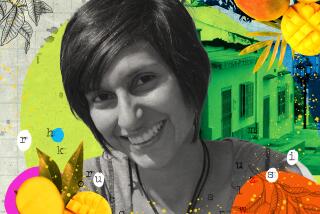DISCOVERIES
Return to Paris
A Memoir
Colette Rossant
Atria Books: 228 pp., $22
Searching for another M.F.K. Fisher, we continue to read juicy books about food and life lived large. Colette Rossant’s childhood was divided between her Egyptian grandparents and her Parisian grandmother: Mommie Dearest was busy dancing and looking for a new husband. At 15, after eight years in Cairo in which the kitchen became her favorite part of the house and the cook her best friend, Rossant was shipped back to Paris, to her grandmother (Cruella De Vil), where her favorite room again became the kitchen and her best friend the cook, Georgette. The recipes throughout are the “prescriptions” that got Rossant through difficult and lonely times: avgolemono, cucumber salad, blanquette de veau, blini.
Breaking rule after rule, she grew into a happy woman, now in her 60s, married a handsome American and never forgot the people along the way who taught her everything she knows about food and love.
*
Dining at the
Lineman’s Shack
John Weston
The University of Arizona Press:
210 pp., $17.95
“Dining at the Lineman’s Shack,” another food memoir, is set in a poor community in 1930s Arizona in the not-so-cozy town of Skull Valley, where John Weston spent his childhood. There are recipes for roasted venison, goat, chile rellenos and something called “Double Boiler Dessert,” to name a few, but you have to be pretty hungry to try the mountain lion, the snake and the “Unknowable Parts,” but it can be fun to read about the suffering of others.
Weston loves oxtail stew but draws the line, like so many of us, at tripe. He grew up hunting pigeon, rabbit, quail and you name it in what he calls “the intelligible wilderness” of Arizona. They knew what was edible, he writes: “a certain little bulb ... possibly a wild garlic ... black walnuts .... Wild grapes, no bigger ‘n’ a minute, and elderberries from which Eloine [the author’s mother] made a jam.”
*
Coming of Age
as a Poet
Milton, Keats, Eliot, Plath
Helen Vendler
Harvard University Press:
174 pp., $22.95
So much time of late has been spent trying to keep poetry alive and afloat by extending its reach and the number of its readers that close analysis of the language and form has been marginalized. But that hasn’t stopped Helen Vendler from making books that assume both the interest and scholarship of her readers, inside and outside of academia. Reading a Vendler essay is like coming home to the cave; like entering the mind of the poet.
In “Coming of Age as a Poet,” a collection of four essays, Vendler looks at the point in the lives of four poets -- John Milton, John Keats, T.S. Eliot and Sylvia Plath -- when they came into their own maturity as poets, found their discourses, the styles and the voices that would make them immortal. She chooses, for each, the “perfect poem,” usually written in their early 20s.
All too often these poets arrive on our shelves fully formed and commanding respect. Vendler shows them on their vulnerable ascents to greatness. In Milton’s “L’Allegro,” we see the expansion of his “imaginative ambition.” In Keats’ sonnet “On First Looking Into Chapman’s Homer,” we see his appetite for experience and his newfound ability to match his imagery to that experience. In Eliot’s “The Love Song of J. Alfred Prufrock,” we see the poet “making decisions about his own convictions,” beginning his true task of fusing his artistic, social and “alienated erotic selves.” In Plath, we watch her build to “The Colossus” and then “The Edge,” coming to terms and to maturity in dealing with her father’s death when she was 8. (Messy sensuality and cold perfection begin the long battle that will play itself out in her poetry.) When reading a Vendler essay, you can choose your own level: undergrad or PhD. No one is watching.
More to Read
Sign up for our Book Club newsletter
Get the latest news, events and more from the Los Angeles Times Book Club, and help us get L.A. reading and talking.
You may occasionally receive promotional content from the Los Angeles Times.







